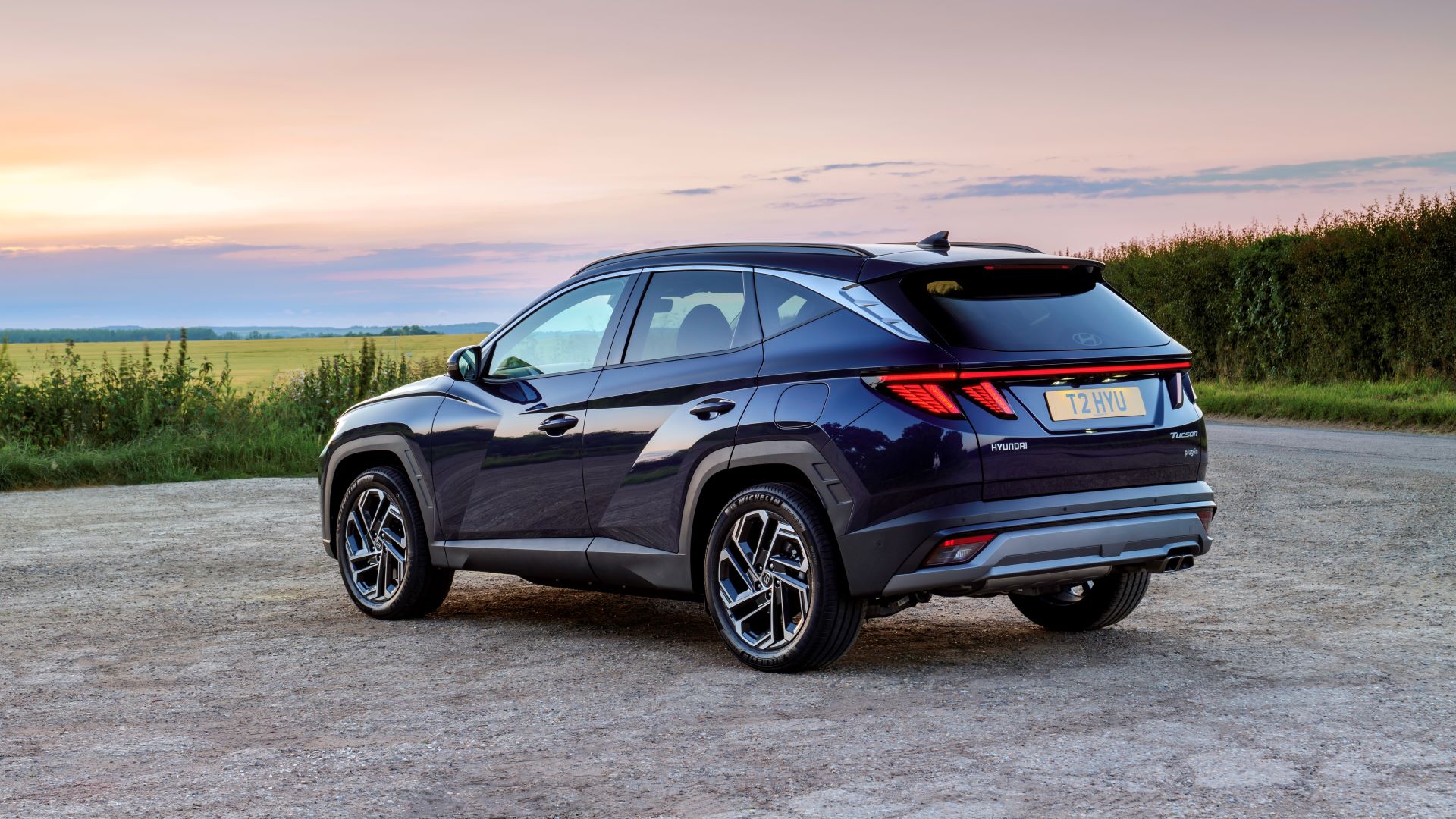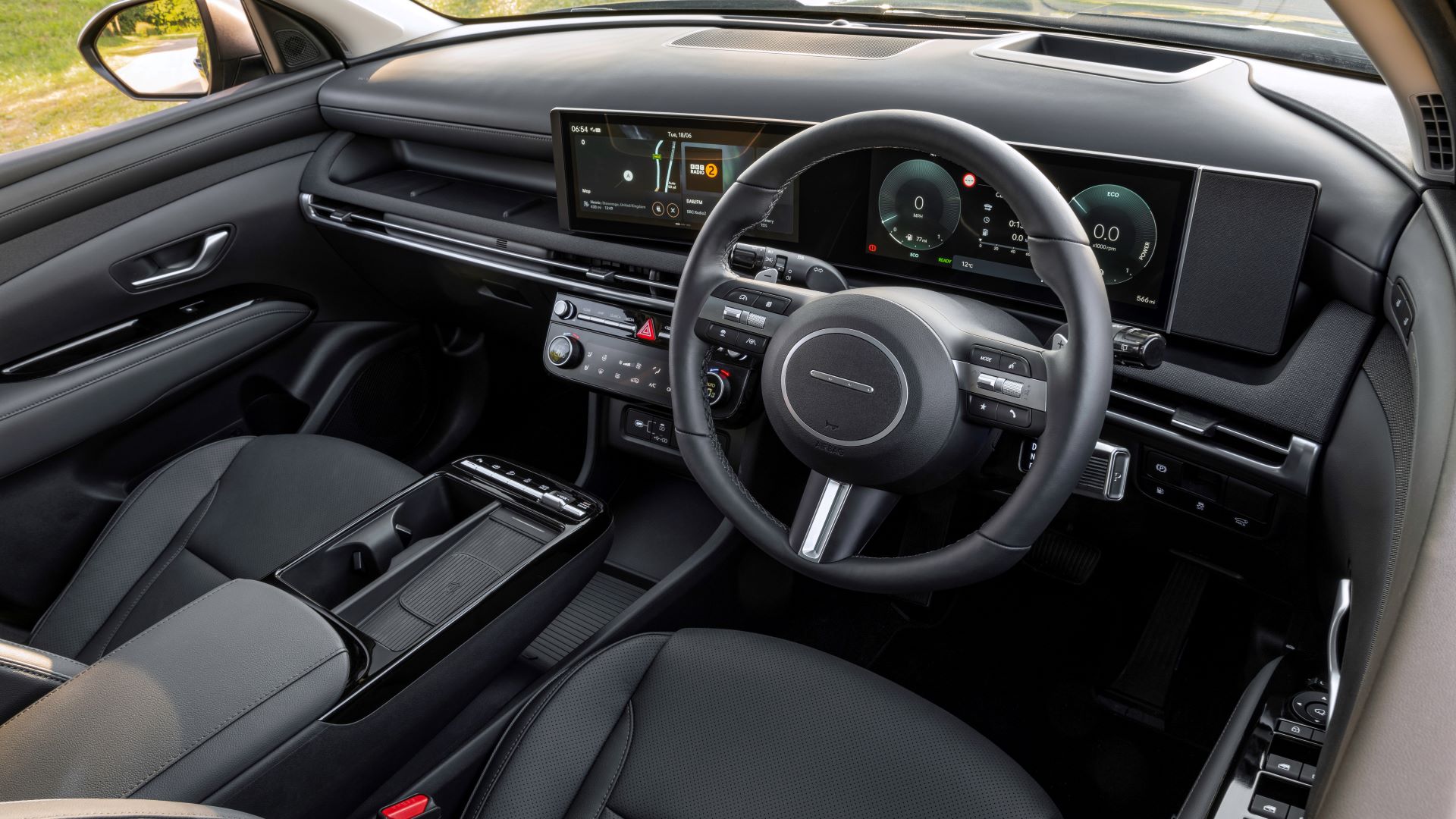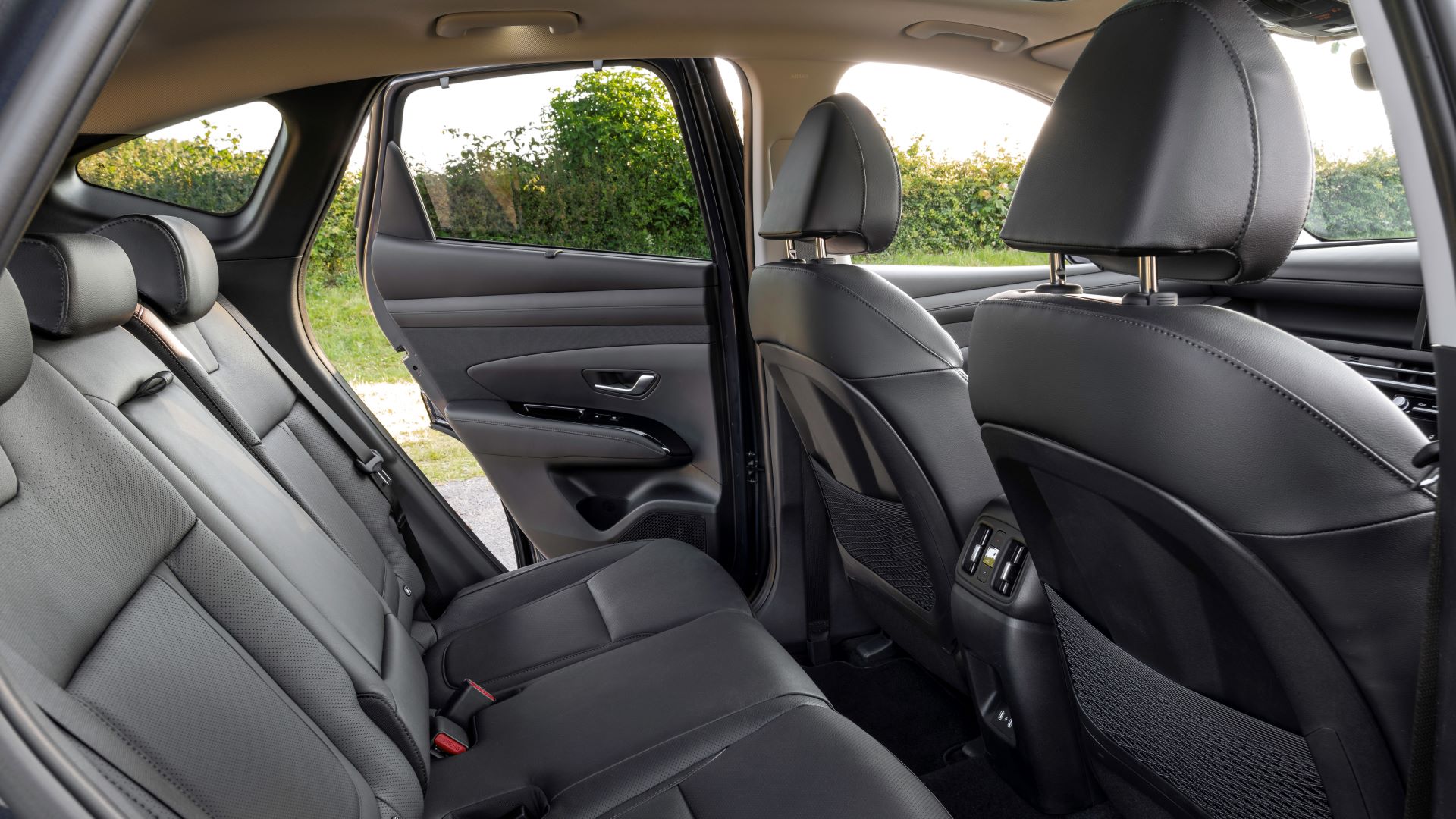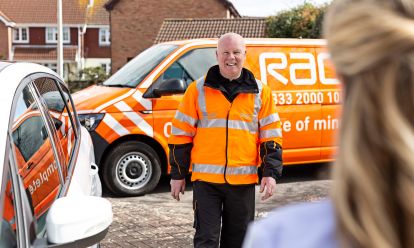
RAC sale – up to 33% off*
• Roadside cover from £5.29 a month†
• We get to most breakdowns in 60 mins or less
• Our patrols fix 4/5 breakdowns on the spot

The Hyundai Tucson has received a raft of updates for 2025. Is it still among the best family SUVs on the market? We find out.
Things you'll like
- Practical, user-friendly interior
- Comfortable ride
- Classy and well-equipped inside
Things to consider
- Not the sharpest drive
- Hybrid rivals are more efficient
- Engine gets noisy when revved
What is the Hyundai Tucson Hybrid?
The Hyundai Tucson is a mid-size family SUV that’s often near the top of buyers’ wishlists. We know that because it’s the Korean brand’s biggest global seller and one of the top 10 most popular cars in the UK.
Shunning the smart but conventional look of previous versions, this fourth-gen Tucson (the second-gen was called iX35 in our market) caused a real stir when it launched in 2020.
It’s bold, previously divisive exterior design no doubt turns fewer heads than it did half a decade ago. But in offering petrol, mild-hybrid, full hybrid and plug-in hybrid power options it set the tone for many SUV rivals since.
It’s also far from the newest kid on the block now, which is why Hyundai revised the Tucson’s exterior look and tweaked the cabin. Here we test the 2024-on Tucson in best-selling hybrid form to see if it still deserves to outsell key rivals.
Verdict: is the Hyundai Tucson a good car?
We reckon the Hyundai Tucson’s all-round abilities keep it among the best family SUVs on sale for those who value comfort, practicality and equipment over driver appeal. It puts comfort and smoothness over an engaging feel at the wheel, while hybrid rivals are more efficient on paper, but the upmarket cabin and improved storage make this an even better version of a strong package.
Pricing, specs & rivals
The entry-level Tucson Hybrid Advance kicks off the range from £36,220 (correct as of August 2025). That’s around £1,800 more than the equivalent Kia Sportage Hybrid, but it does come with more standard kit.
It’s also a good deal cheaper than the Ford Kuga FHEV (because Ford doesn’t offer the hybrid in the cheapest Kuga trim), although the Nissan Qashqai e-Power and Renault Austral both undercut the Hyundai. If value for money matter most, though, the Dacia Bigster hybrid is significantly cheaper than all of these.

The Tucson Hybrid range also includes Premium trim, priced from £38,720, N Line trim for a whole £100 more, and top-spec Ultimate and N Line S trim which both command the same £41,320 cash price.
Advance trim comes with a generous level of standard equipment including 17in alloys, privacy glass, dual-zone climate control, cruise control, 64-colour ambient lighting, a reversing camera and a wireless phone charging pad.
Stepping up to Premium trim brings 18in alloys, part leather upholstery, heated front and rear seats, a heated steering wheel, sunshades for the rear side windows, an electric tailgate, adaptive cruise control and a premium sound system upgrade. N Line drops the heated rear seats and part leather in favour of bigger 19in alloys and sporty styling upgrades inside and out.
Range-topping Ultimate brings full leather, 19in alloys, ventilated seats, a head-up display, LED matrix headlights, a panoramic sunroof and a 360-degree camera system. N Line S is basically the same, but switches out leather for part faux-suede and has a sportier look.
Rivals
We expect you’ll be considering the Kia Sportage Hybrid as an alternative to the Tucson – indeed, both cars are very similar underneath.
But it’s also worth checking out the Nissan Qashqai e-Power, Renault Austral, Ford Kuga and Dacia Bigster, along with the slightly larger Toyota RAV4 and Honda CR-V – all offer non plug-in hybrid engine options.
If not having a full hybrid option isn’t a dealbreaker, then check out the VW Tiguan, Skoda Karoq, Peugeot 3008 and Vauxhall Grandland as capable family SUV options.
Interior comfort, quality & technology
The Tucson’s cabin changed quite a lot as part of the 2024 update, with a completely redesigned dashboard aimed at boosting user-friendliness.
While the outgoing version features a screen in the centre of the dashboard and a separate dial display, the updated version combines the two screens in a bezel mounted higher up on the dash, within the driver’s line of sight. It’s a much more modern layout but also has usability benefits.
The older model also had a rather daunting mix of touch-sensitive buttons below the screens to control various functions. These have now been replaced by two much simpler-to-use stacks of physical button shortcuts, and new knobs for the climate functions. It’s a more intuitive layout.
The gear selector has been moved on to the steering column (more on that in the practicality section) while the steering wheel loses the old Hyundai ‘H’ logo for the brand’s newer design. Much of it will be familiar if you’ve experienced Hyundai’s newer models, like the Santa Fe and IONIQ 5.
The driving position is comfortable and widely adjustable, if not as lofty as some SUVS. Visibility is good, too – better, in fact, than the Kia Sportage thanks to larger rear side windows and a low bonnet. Chunky rear pillars mean relying on the various camera systems offered across the Tucson range when parking, however.
Material quality (already good in the older model) takes a further step forward, with plenty of soft touch finishes and well-damped switches. It feels more upmarket inside than a Ford Kuga or Dacia Bigster, that’s for sure.

Infotainment, sat-nav, stereo and connectivity
Every Tucson now features a 12.3-inch touchscreen display paired to an identically sized instrument display within a single bezel on the dash top. It’s a trend started by brands such as Mercedes-Benz but now mimicked by a wide variety of models.
The new display’s position on the dash makes it easier to glance at while driving and the graphics are clear, while it’s intuitive to operate and responds quickly enough. Granted, a Renault Austral’s touchscreen looks sharper and has built-in Google tech, but the Hyundai’s system is good enough for most people’s needs.
The physical menu shortcuts also make finding functions easy on the move, while neat shortcuts help you cut down on the beeps and bongs: the speed warning can be silenced simply by holding the mute button, for example.
The instrument display is also clear and bright, with graphics that alter depending on your drive mode. Of course, all versions have wireless Android Auto and Apple CarPlay, but a wireless phone charging pad is standard, too, as are front and rear USB-C connections.
The standard six-speaker sound system is perfectly respectable for a mainstream family SUV, but the upgraded eight-speaker Krell system in Premium trim and above is a good deal punchier.
How practical is the Hyundai Tucson?
Even with newer and larger family SUVs hitting the market since the Tucson, it still offers loads of space by the standards of the class.
Up front even the tallest or broadest of adults can stretch out in comfort, with plenty of space in all dimensions and enough width to avoid banging elbows with the person alongside. Headroom isn’t in short supply even with the panoramic roof fitted, either.
There’s also plenty of space in the back seats, with two six-footers able to sit comfortably even with large adults forcing the front seats further back. Headroom is great, too, and the raised front seating position makes it easy for those in the back to slide their feet underneath the seats – further aiding comfort along with the soft yet supportive seats. Reclining backrests also feature, too, but the seat bases don’t slide back and forth like in some rivals.
There is a central tunnel in the footwell, unlike in a Ford Kuga, which impedes foot space a little for a third rear passenger. But there’s enough width for five people to get relatively comfortable for longer journeys in the Tucson.
Storage and boot space
Hyundai has improved a few areas of the Tucson’s front cabin to improve practicality, and one of those is storage spaces.
The old car’s swooping dash design has been replaced (on the passenger side at least) by a generous cut-out shelf above the glovebox. It’s plenty big enough for phones, wallets or your lunch on the go, and is a useful touch.
Another revision is the centre console, which becomes a whole lot more usable. Where previously you’d have a bulky console housing the gear selector, that’s been moved to a stalk on the steering column – freeing up space for a wireless phone charging pad and a pair of cupholders. The old, hard to reach lower storage area has been opened up to reveal a huge space big enough for a large handbag.
Beyond that you’ll find some space under the centre armrest, a decent glovebox and a pair of door bins that are on the small size. But opening up that centre storage has made a world of difference.
In the rear things haven’t changed much, meaning you’ll find nets for items on the front seatbacks, a pair of cupholders in the centre armrest and another couple of rather pokey door bins. We like that most versions get built-in sun blinds, however.

The Tucson also continues to have a generous boot for family buyers. The Tucson Hybrid’s 616-litre capacity is only four litres down on the regular petrol model (plug-in hybrids lose more capacity to the car’s battery). That’s roomier than most rivals, and bigger still than the Kia Sportage.
It’s a large and square opening, with an electric tailgate on Premium trim and above aiding access. The hybrid version also keeps the height-adjustable boot floor making loading items in and out easy while keeping some underfloor storage.
Folding the seats down is even easier with the latest model, with all versions getting levers mounted on the side of the boot. They split in a 40/20/40 division, too – another practical bonus of a very usable family SUV.
Performance & drive: What is the Hyundai Tucson like on the road?
While pure petrol and mild-hybrid version of the Hyundai Tucson only offer adequate performance at best, the hybrid is noticeably quicker.
The hybrid version uses the same 1.6-litre four-cylinder turbo petrol engine, but with an electric motor also assisting you get 215hp compared to the petrol’s 160hp.
That’s enough for it to feel reasonably brisk by class standards, with plenty of power in reserve to get up to speed on motorway slip roads or safely overtake. The only negative is the rather hesitant kickdown of the six-speed automatic gearbox.
Alternatives like the Qashqai e-Power and Austral E-Tech are a little quicker and more responsive as a result, but none of these hybrid SUVs are sports cars and the Hyundai is perfectly good enough for most people’s needs.
The Tucson hybrid also gets regenerative braking like pretty much all its rivals. It harvests kinetic energy under braking and coasting, but unlike many hybrids you can easily adjust the level of regen effect via paddles mounted on the steering wheel. That makes the Tucson feel a bit more like an EV, and it’s a useful feature.
Power, 0-62mph times
- Tucson Hybrid (all models): 215hp/ 8.2 secs
Ride and handling
Good visibility, combined with light steering and the hybrid’s low-speed smoothness, makes this Tucson a doddle to drive about town for an SUV that you wouldn’t class as small.
Comfort is also a key trait of the Hyundai at any speed. Revisions to the suspension setup in 2024 have given it a more controlled, cushioned ride at low speed without it feeling too floaty over bumpy high-speed roads. We reckon it’s a slightly better compromise than the Kia Sportage, which is a touch better controlled out of town but firmer over low-speed bumps.
You certainly wouldn’t call the Tucson sporty, however – even with the latest revisions. The updated suspension does mean less body lean and a greater sense of composure, but it’s still designed for cruising rather than attacking bends with any gusto.
There’s plenty of grip, but keen drivers will find the steering lacking in confidence-inspiring weight and accuracy, while a VW Tiguan keeps body roll in check better.
Noise and refinement
The hybrid version of the Tucson is much quieter when cruising around town in electric mode than the petrol models. When the battery is depleted, the engine is audible, but it only gets vocal and a bit thrashy if you rev it beyond 4,000rpm. Wind noise is low, too, and road noise is a bit better isolated than in the Kia Sportage – while the ride is a bit smoother in the Hyundai too.

Euro NCAP: is the Hyundai Tucson a safe car?
The Hyundai Tucson achieved the maximum five-star rating from Euro NCAP when put through its crash testing regime, which is in line with the best-in-class family SUVs.
An 86% score for adult occupant protection and 87% score for child occupant protection is identical to the Sportage, but the Nissan Qashqai managed even better. Overall, though, the Hyundai is still a very safe car for occupants – if not class-leading when it comes to vulnerable road user protection.
Every Tucson comes with a host of active safety assist technology including the mandatory automatic emergency braking, lane keep assistance and speed limit recognition.
It also gets trailer stability assist and blind spot monitoring across the range, with junction collision avoidance and highway driving assist added on Premium and N Line trim. Top-spec models also add Hyundai’s handy Blind Spot View Monitor, which displays a camera image of your blind spots when you indicate.
Running costs and fuel economy
The benefits of the full hybrid system are clear when you compare the Tucson Hybrid to its petrol and mild hybrid equivalents – which use the same engine yet produce less power.
The Tucson Hybrid manages up to 48.7mpg in the combined WLTP test. That figure drops by around 1mpg with the larger 19in wheels, while the four-wheel drive version manages 42.8mpg.
Compare that to a maximum of 41.4mpg combined for the regular 160hp 1.6T petrol Tucson, and 44.8mpg for the mild-hybrid, and the benefits are obvious – particularly below 40mph or so where the electric element of the hybrid comes into its own.
Unfortunately, while the Tucson Hybrid’s figures are pretty good in isolation, they fall short of what newer alternatives promise. While these figures beat the Honda CR-V, rivals from Ford and Toyota claim 50mpg-plus, while the latest evolution of hybrids from Nissan and Renault are capable of over 60mpg in official tests.
Still, the good news is that it’s possible to get a well-equipped Tucson Hybrid under the £40,000 list price barrier, meaning only the highest-spec versions are subject to the Expensive Car Supplement – an additional car tax that applies from the second to the sixth year after the car’s registration.
How much does the Hyundai Tucson Hybrid cost to insure?
The Hyundai Tucson Hybrid sits in insurance group 20 for the base Advance model, only rising to group 21 for the highest-spec trims.
That means it shouldn’t break the bank when it comes to insurance costs, with the groups slightly lower than the equivalent Sportage and in line with the Ford Kuga.
Hyundai Tucson FAQs
Is the Hyundai Tucson a self-charging hybrid?
Yes, the Hyundai Tucson Hybrid is a self-charging hybrid, using regenerative braking or petrol power to charge up the battery. That means it can quickly cycle between petrol or electric power depending on your speed and acceleration. You can also buy a Tucson PHEV, which is a plug-in hybrid.
What’s the point of a self-charging hybrid?
A self-charging hybrid allows a small amount of electric-only running before the petrol engine kicks in, but it quickly charges up as you drive along, meaning you constantly switch between the two power sources. The makes it more efficient at low speeds and in traffic, while also being smoother and faster than Hyundai’s pure petrol version.
Can the Tucson hybrid run on electric power alone?
The Tucson hybrid can only manage a mile or two at best in electric power alone before the engine kicks in. However, the battery charges quickly within a few miles, so it will drop back into EV mode when able and juggle both power sources.













